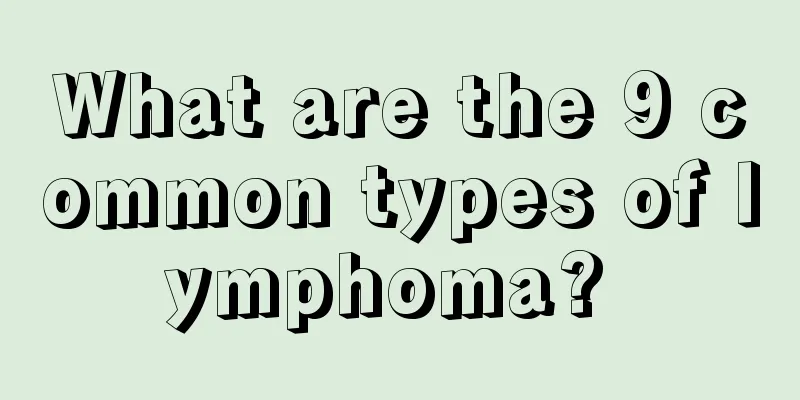What are the 9 common types of lymphoma?

|
Lymphoma originates from the lymphatic tissue of the human body. Lymph is distributed throughout the human body. The so-called lymphatic system includes lymphatic tissue and organs, such as the spleen and tonsils. It also includes a type of lymph node white blood cells and bean-shaped lymph nodes, which function to fight against infections caused by bacteria. The following are 9 common types of lymphoma commonly seen in clinical practice. Clinical manifestations Malignant lymphoma is a tumor with great heterogeneity. Although lymphoma often occurs in lymph nodes, due to the distribution characteristics of the lymphatic system, lymphoma is a systemic disease that can invade almost any tissue and organ in the human body. Therefore, the clinical manifestations of malignant lymphoma not only have certain common characteristics, but also vary greatly according to different pathological types, locations and invasion ranges. Local manifestations are superficial and deep lymphadenopathy, which are mostly painless, smooth, active, and hard, full, and uniform. Early activities are isolated or scattered in the neck, axilla, groin, and other parts. Pharyngeal lymphatic ring lesions The oropharynx, tongue root, tonsils, and nasopharyngeal mucosa and mucosa are rich in lymphoid tissue, which is composed of pharyngeal lymphatic rings, also known as Wedeley's rings, which are prone to malignant lymphoma; primary nasal lymphoma is mainly NHL, and the main pathological types are NK/T cell lymphoma and diffuse large B cell lymphoma. Chest lesions Mediastinal lymph nodes are common sites of malignant lymphoma, mainly seen in primary mediastinal large B cell lymphoma and HL, NHL precursor cell lymphoma. There are round or quasi-circular or lobed shadows on the chest X-ray. The progression of the lesion may lead to bronchial atelectasis, and sometimes the central necrosis of the tumor forms a cavity. Some lung lesions show diffuse interstitial changes, and clinical symptoms are obvious at this time, often with cough, sputum, shortness of breath, and dyspnea. Secondary infection may be accompanied by fever; malignant lymphoma invades the myocardium and pericardium, manifesting as pericardial effusion, and lymphoma invades the myocardium, manifesting as cardiomyopathy, arrhythmia, and abnormal electrocardiogram. The abdominal spleen is the most common subdiaphragmatic invasion site of HL. The gastrointestinal tract is the most common extra-orbital lesion site of NHL. Mesenteric, retroperitoneal, and iliac fossa lymph nodes are also common invasion sites of lymphoma. Cutaneous malignant lymphoma can be primary or secondary invasion of the skin, which is more common in non-Hodgkin's lymphoma. Bone marrow infiltration of myeloid malignant lymphoma is manifested as bone marrow infiltration or combined with leukemia, which is often one of the late manifestations of the disease, mostly NHL. Neurological manifestations: Other manifestations include progressive multifocal leukoencephalopathy, subacute necrotizing myelopathy, sensory or motor neuropathy, and multiple myopathy. Malignant lymphoma may also originate primarily or secondarily in the brain, epidural, testicles, ovaries, vagina, cervix, breast, thyroid, adrenal glands, orbital tissue, larynx, and skeletal muscle and soft tissue. The clinical manifestations are complex and varied, and care should be taken to differentiate them. Systemic manifestations include Systemic symptoms Malignant lymphoma may cause systemic symptoms such as fever, itching, night sweats, and weight loss before or at the same time as lymph node enlargement. Immune and blood system performance When malignant lymphoma is diagnosed, 10% to 20% may develop anemia, some patients may have increased white blood cell count, thrombocytosis, and erythrocyte sedimentation rate, and some patients may have leukemic reactions with a significant increase in neutrophils. Increased lactate dehydrogenase is related to tumor load. Some patients, especially those in the advanced stage, have abnormal immune function. In B-cell NHL, different amounts of monoclonal immunoglobulins can be detected in the serum of some patients. Skin lesions Patients with malignant lymphoma may have a series of nonspecific skin manifestations, including polymorphism, erythema, blisters, erosions, etc. Patients with advanced malignant lymphoma have low immune function, and skin infections often ulcerate and exude for a long time, forming systemic scattered skin thickening and peeling. 1. Marginal zone lymphoma: refers to lymphoma originating from B cells between marginal zone lymph follicles and follicular mantles. It can be divided into lymph node marginal zone B cell lymphoma, splenic marginal zone cell lymphoma and extranodal marginal zone B cell lymphoma of mucosa-associated lymphoid tissue. |
<<: Do you know the cost of gene testing for targeted therapy? Let me tell you in detail below
>>: What is endocrine therapy for prostate cancer?
Recommend
What causes lung cancer? Revealing the three main pathogenic factors of lung cancer
There are many factors in our daily life that can...
At what temperature is formaldehyde released
Formaldehyde is usually released only under certa...
What causes nosebleeds while swimming
Many people like swimming very much, especially t...
What is the best way to remove phlegm?
When phlegm appears in the throat, people will fe...
What is a spa
Everyone must have heard of spa, and many people ...
How to treat congenital scoliosis, choose the method according to the situation
There are two types of treatments for congenital ...
Baking soda removes acne marks
Baking soda is actually a chemical product. It is...
Where is the ear cartilage
Many people choose autologous cartilage rhinoplas...
Is it good to be pregnant with skin cancer
When it comes to cancer, everyone is in a panic. ...
Why do I feel dizzy all of a sudden?
Dizziness is a very common phenomenon in life. It...
How many days after dyeing can you wash your hair? You must pay attention to these matters
For female friends, dyeing hair is a common thing...
What factors may cause the occurrence of cardia cancer?
The occurrence of cardia cancer is common in life...
Does early laryngeal cancer need chemotherapy after surgery?
The treatment method should be based on the scope...
What are the benefits of soaking your feet in ginger slices
When many people can't sleep in winter, they ...
What are the causes of lumps in the breast?
Feeling a lump in the breast is a common phenomen...









